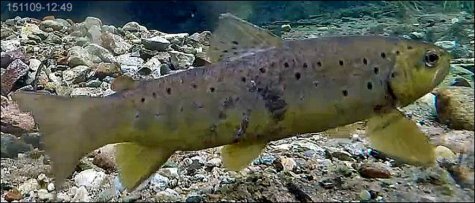Fish Camera
VIDEO: Otter on spawning ground
Video recorded by Urmas Lett, www.eenet.ee
Translation Liis
Otter Harilik saarmas Lutra lutra
On Tuesday night an otter turned up in camera view; careless spawners may be a quite easy prey to it. On the sides of several trout we can see marks from both claws and teeth. When swimming, an otter’s nose as well as eyes are visible above the water, it also knows how to dive silently.
The adaption to life in water is visible at once: a streamlined and slim body, tail with broad base and narrow tip making up more than half of the total length of the otter. The short limbs have 5 webbed toes.
The solitarily living otter is a mustelid with a semi-aquatic life style: the largest semi-aquatic predator in our waters. The body length of adult male otters can reach over a meter, weight is around 10 kilos. Females and of course young animals are up to one third smaller. It has a dense, beautiful, waterproof and extremely durable brown coat – up to 50 000 hairs grow on one square centimetre of otter skin! In water air bubbles remain between the hairs of the undercoat, and so only the topcoat of the otter becomes wet. The coat colour is brown, belly slightly lighter. In the flat head we notice whitish lips; the otter’s cheeks and throat are similarly whitish.
Otters mostly become active at dusk, after midnight they go to rest for a few hours. How and by what means do otters orientate in muddy waters and darkness? Although they see quite well under water, the long sensitive whiskers help when hunting to transmit additional information. During a dive otters close both the nostrils and ears; they stay under water for barely half a minute. Those who have had the chance to meet them in nature know.
What do they eat in autumn and winter? In the feeding places of otters we mostly find remains of fish, the staple food of otters. Of course they hunt frogs that have crawled into the bottom mud for winter, molluscs and crayfish (if they should be present in the water system); on the ground they hunt small rodents in autumn. Something is always left lying about in the feeding areas – when the head part and other better bits have been eaten the tail end is left among the scales. The remains will not be around for long – there are plenty of observant eyes around, and food is not to be wasted…
A day and night food need is up to one or one and a half kilo, and a night-time hunting trip may be 3 kilometres long, in case of lack of food up to 10 kilometres.
Severe winters with thick ice covers turn out to be quite difficult to survive for the skilful hunters. By spring the weight of otters has decreased by one-third.
Its action area is marked with excrement piles in visible spots such as for instance places where they get out of water: on stones, tree stubs and trunks, banks. Otter excrements are easily identifiable, slimy when fresh, coloured dark green to blackish, containing both fish scales and bones and smelling of whale oil or fish.
If the entrances to the otter’s burrow are left below the water level the nest chamber must have an airing hole. Generally otters have several burrows.
Otter tracks can be spotted even on shore sand. The sea water around Estonia is so little salty that otters come to find fish in the shore waters, but nesting places have as far as is known notyet been found at the seashore.









